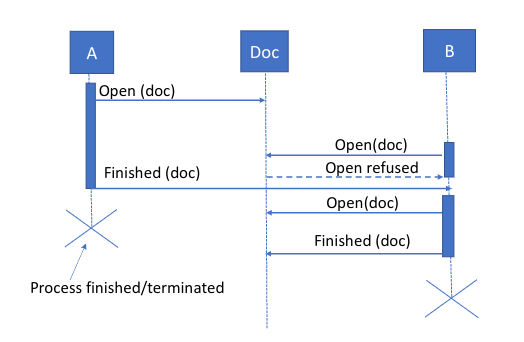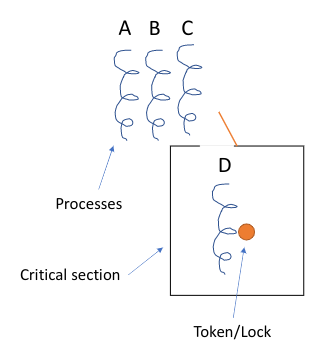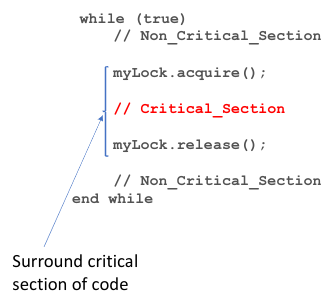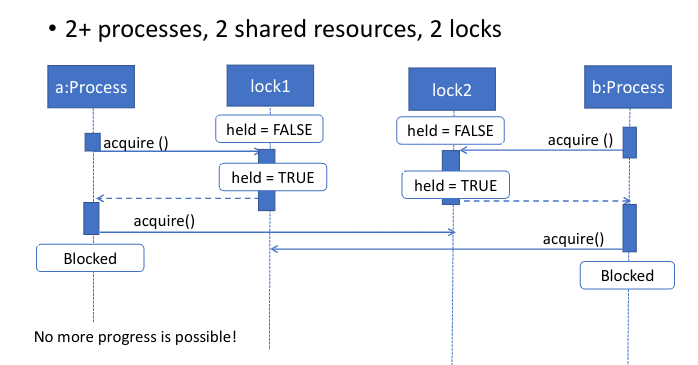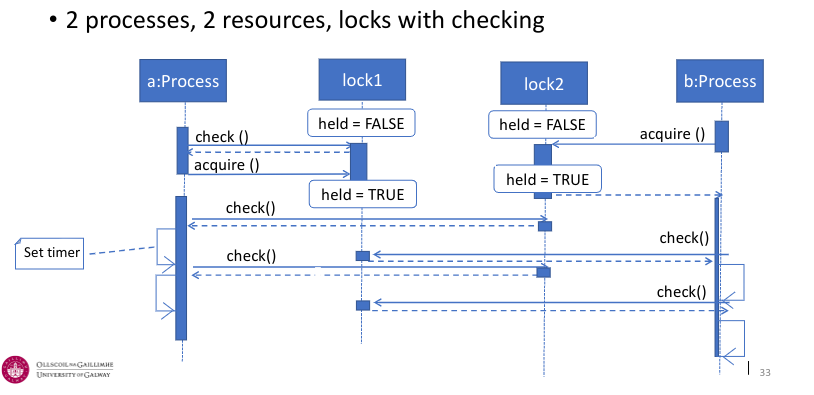25 KiB
25 KiB
- #CT213 - Computer Systems & Organisation
- Previous Topic: CPU Management - Scheduling
- Next Topic: Memory Management
- Relevant Slides:
-
Concurrent Programming
collapsed:: true- What are Concurrent Programs? #card
card-last-interval:: 4
card-repeats:: 2
card-ease-factor:: 2.22
card-next-schedule:: 2022-11-21T09:47:57.127Z
card-last-reviewed:: 2022-11-17T09:47:57.127Z
card-last-score:: 3
- Concurrent Programs are interleaving sets of sequential atomic instructions.
- i.e., interacting sequential processes that run at the same time, on the same or different processors.
- Processes are interleaved - at any time, each processor runs an instruction of the sequential processes.
- Concurrent Programs are interleaving sets of sequential atomic instructions.
-
Correctness
- Generalisation: A program will be correct if its preconditions hold, as then its post conditions will also hold.
- A concurrent program must be correct under ^^all possible interleavings.^^
- If all the maths is done in registers, then the results will depend on interleaving (indeterminate calculation).
- This dependency on unforeseen circumstances is known as a Race Condition.
- What is a Race Condition? #card
card-last-interval:: 0.88
card-repeats:: 2
card-ease-factor:: 2.36
card-next-schedule:: 2022-11-18T06:49:18.142Z
card-last-reviewed:: 2022-11-17T09:49:18.143Z
card-last-score:: 3
- A Race Condition occurs when a program output is dependent on the sequence or timing of code execution.
- If multiple processes of execution enter a critical section at about the same time, both will attempt to update the shared data structure.
- This will lead to surprising & undesirable results.
- You must work to avoid this with concurrent code.
- If we get different results every time we run some code, the result is indeterminate.
- What is a Critical Section? #card
card-last-interval:: -1
card-repeats:: 1
card-ease-factor:: 2.36
card-next-schedule:: 2022-11-18T00:00:00.000Z
card-last-reviewed:: 2022-11-17T09:47:41.294Z
card-last-score:: 1
- A critical section is a part of a program where a shared resource is accessed.
- A critical section must be protected in ways that avoid concurrent access.
- A critical section is a part of a program where a shared resource is accessed.
- What are Deterministic Computations? #card
card-last-interval:: 0.98
card-repeats:: 2
card-ease-factor:: 2.36
card-next-schedule:: 2022-11-15T19:07:48.411Z
card-last-reviewed:: 2022-11-14T20:07:48.412Z
card-last-score:: 3
- Deterministic Computations have the same result each time.
- We want deterministic concurrent code.
- We can use synchronisation mechanisms.
- Deterministic Computations have the same result each time.
-
Handling Race Conditions
- We need a mechanism to control access to shared resources in concurrent code - Synchronisation is necessary for any shared data structure.
- The idea is to focus on the critical sections of the code, i.e., sections that access shared resources.
- We want critical sections to run with mutual exclusion - only one process should be able to execute that code at the same time.
-
Critical Section Properties #card
card-last-interval:: 0.98 card-repeats:: 2 card-ease-factor:: 2.36 card-next-schedule:: 2022-11-24T11:17:06.949Z card-last-reviewed:: 2022-11-23T12:17:06.950Z card-last-score:: 3- Mutual Exclusion: Only one process can access the critical section at a time.
- Guarantee of Progress: Processes outside the critical section cannot stop another from entering it.
- Bounded Waiting: A process waiting to enter the critical section will eventually enter.
- Processes in the critical section will eventually leave.
- Performance: The overhead of entering / exiting should be small.
- Fair: Don't make certain processes wait much longer than others.
-
Atomicity #card
card-last-interval:: -1 card-repeats:: 1 card-ease-factor:: 2.5 card-next-schedule:: 2022-11-18T00:00:00.000Z card-last-reviewed:: 2022-11-17T09:48:51.808Z card-last-score:: 1- Basic atomicity is provided by the hardware.
- E.g., References & Assignments (i.e., read & write operations) are atomic in all CPUs.
- However, higher-level constructs (i.e., any sequence of two or more CPU instructions) are not atomic in general.
- Some languages (e.g., Java) have mechanisms to specify multiple instructions as atomic.
- Basic atomicity is provided by the hardware.
-
Conditional Synchronisation
- What are Concurrent Programs? #card
card-last-interval:: 4
card-repeats:: 2
card-ease-factor:: 2.22
card-next-schedule:: 2022-11-21T09:47:57.127Z
card-last-reviewed:: 2022-11-17T09:47:57.127Z
card-last-score:: 3
-
Mutual Exclusion Solutions
collapsed:: true-
Locks
collapsed:: true- What is a lock? #card card-last-interval:: -1 card-repeats:: 1 card-ease-factor:: 2.5 card-next-schedule:: 2022-11-16T00:00:00.000Z card-last-reviewed:: 2022-11-15T18:42:37.491Z card-last-score:: 1
-
Lock States & Operation #card
card-last-interval:: 0.95 card-repeats:: 2 card-ease-factor:: 2.36 card-next-schedule:: 2022-11-22T11:06:37.168Z card-last-reviewed:: 2022-11-21T13:06:37.168Z card-last-score:: 3- Locks have 2 states:
- Held: Some process is in the critical section.
- Not Held: No process is in the critical section.
- Locks have 2 operations:
- Acquire: Mark lock as held or wait until released. If not held, this is executed immediately.
- If many processes call acquire, only one process can get the lock.
- Release: Mark lock as not held.
- Acquire: Mark lock as held or wait until released. If not held, this is executed immediately.
- Locks have 2 states:
-
Using Locks #card
card-last-interval:: 2.8 card-repeats:: 2 card-ease-factor:: 2.6 card-next-schedule:: 2022-11-17T15:07:42.144Z card-last-reviewed:: 2022-11-14T20:07:42.144Z card-last-score:: 5 -
Lock Benefits #card
card-last-interval:: -1 card-repeats:: 1 card-ease-factor:: 2.5 card-next-schedule:: 2022-11-18T00:00:00.000Z card-last-reviewed:: 2022-11-17T19:36:01.540Z card-last-score:: 1- Only one process can execute the critical section code at a time.
- When a process is finished (& calls
release()), another process can enter the critical section. - Achieves the requirements of mutual exclusion & progress for concurrent systems.
-
Lock Limitations #card
card-last-interval:: 0.98 card-repeats:: 2 card-ease-factor:: 2.36 card-next-schedule:: 2022-11-15T19:09:12.011Z card-last-reviewed:: 2022-11-14T20:09:12.011Z card-last-score:: 3- Acquiring a lock only blocks processes trying to acquire the same lock.
- Process may acquire other locks.
- ^^You must use the same lock for all critical sections accessing the same data (or resource).^^
- Acquiring a lock only blocks processes trying to acquire the same lock.
-
Hardware-Based Lock
- Processor has a special instruction called "test & set".
- Allows atomic read and update.
-
//c code for test and set behaviour bool test_and_set (bool *flag) { bool old = *flag; *flag = true; return old; }
- Processor has a special instruction called "test & set".
-
Hardware-Based Spinlock
-
struct lock { bool held; //initially FALSE } void acquire(lock) { while(test_and_set(&lock->held)) ; //just wait return; } void release(lock) { lock->held = FALSE; } -
Drawbacks of Spinlocks #card
card-last-interval:: 3.45 card-repeats:: 2 card-ease-factor:: 2.46 card-next-schedule:: 2022-11-18T06:09:40.073Z card-last-reviewed:: 2022-11-14T20:09:40.073Z card-last-score:: 3- Spinlocks are a form of busy waiting -> they burn CPU time.
- Once acquired, they are held until explicitly released.
- Inefficient if the lock is held for long periods.
- OS overhead of context switching.
- If the Process Scheduler makes processes sleep while the lock is held, all other processes use their CPU time to spin while the process with the lock make no progress.
-
-
Do locks give us sufficient safety? #card
card-last-interval:: -1 card-repeats:: 1 card-ease-factor:: 2.5 card-next-schedule:: 2022-11-15T00:00:00.000Z card-last-reviewed:: 2022-11-14T20:24:13.793Z card-last-score:: 1- If you can demonstrate any cases in which the following properties do not hold, then the system is not correct.
-
- Check Safety Properties: These must always be true.
- Mutual Exclusion: Two processes must not interleave certain sequences of instructions.
- Absence of Deadlock: Deadlock is when a non-terminating system cannot respond to any signal.
-
- Check Liveness Properties: These must eventually be true.
- Absence of Starvation: Information that is sent is delivered.
- Fairness: Any contention must be resolved.
-
- If you can demonstrate any cases in which the following properties do not hold, then the system is not correct.
-
Lock Deadlock Scenario
-
Protocols to Avoid Deadlock #card
card-last-interval:: -1 card-repeats:: 1 card-ease-factor:: 2.5 card-next-schedule:: 2022-11-15T00:00:00.000Z card-last-reviewed:: 2022-11-14T20:09:06.660Z card-last-score:: 1- Add a timer to the
lock.request()method.- Cancel the job & attempt it another time if it takes too long.
- Add a new
lock.check()method to see if a lock is already held before requesting it.- You can do something else and come back & check again.
- Avoid hold & wait protocol.
- Never hold onto one resource when you need two.
- Add a timer to the
-
Livelock by trying to avoid deadlock
-
Starvation
- What is Starvation? #card
card-last-interval:: -1
card-repeats:: 1
card-ease-factor:: 2.5
card-next-schedule:: 2022-11-15T00:00:00.000Z
card-last-reviewed:: 2022-11-14T20:08:54.153Z
card-last-score:: 1
- Starvation is a more general case of livelock.
- One or more processes do not get run as another process is locking the resource.
- Starvation is a more general case of livelock.
- What is Starvation? #card
card-last-interval:: -1
card-repeats:: 1
card-ease-factor:: 2.5
card-next-schedule:: 2022-11-15T00:00:00.000Z
card-last-reviewed:: 2022-11-14T20:08:54.153Z
card-last-score:: 1
-
Locks / Critical Sections & Reliability
- What if a process is interrupted, suspended, or crashes inside its critical section? #card
card-last-interval:: -1
card-repeats:: 1
card-ease-factor:: 2.5
card-next-schedule:: 2022-11-15T00:00:00.000Z
card-last-reviewed:: 2022-11-14T16:17:34.955Z
card-last-score:: 1
- In the middle of the critical section, the system may be in an inconsistent state. The process is holding a lock, and if it dies, no other process waiting on that lock can proceed.
- Developers must ensure that critical regions are very short and always terminate.
- What if a process is interrupted, suspended, or crashes inside its critical section? #card
card-last-interval:: -1
card-repeats:: 1
card-ease-factor:: 2.5
card-next-schedule:: 2022-11-15T00:00:00.000Z
card-last-reviewed:: 2022-11-14T16:17:34.955Z
card-last-score:: 1
-
Beyond Locks
- Locks only provide mutual exclusion.
- They ensure that only one process is in the critical section at a time.
- Locks are good for protecting our shared resource to prevent race conditions & avoid non-deterministic execution.
- What about fairness, avoiding starvation, & livelock?
- We need to be able to place an ordering on the scheduling of a process.
- Locks only provide mutual exclusion.
-
Semaphores
collapsed:: true- Example: We want to place an order on when processes execute.
background-color:: green
- Producer-Consumer:
- Producer: Creates a resource (data).
- Consumer: Uses a resource (data).
- E.g.:
ps | grep "gcc" | wc.
- E.g.:
- Don't want producers & consumers to operate in lockstep (i.e., atomicity).
- Each command must wait for the previous output.
- Implies lots of context switching (i.e., very expensive).
- ^^Solution: Place a fixed-size buffer between producers & consumers.^^
- ^^Synchronise access to buffer.^^
- ^^Producer waits if the buffer is full; the consumer waits if the buffer is empty.^^
- Producer-Consumer:
- What is a semaphore? #card
card-last-interval:: -1
card-repeats:: 1
card-ease-factor:: 2.5
card-next-schedule:: 2022-11-15T00:00:00.000Z
card-last-reviewed:: 2022-11-14T15:50:12.454Z
card-last-score:: 1
- A semaphore is a higher-level synchronisation primitive.
- Semaphores are a kind of generalised lock.
- They are the main synchronisation primitive used in the original UNIX.
- Semaphores are implemented with a counter that is manipulated atomically via 2 operations: signal & wait.
wait(semaphore): AKAdown()orP().- Decrement counter.
- If counter is zero, then block until semaphore is signalled.
signal(semaphore): AKAup()orV().- Increment counter.
- Wake up one waiter, if any.
sem_init(semaphore, counter):- Set initial counter value.
-
Semaphore PseudoCode #card
card-last-interval:: -1 card-repeats:: 1 card-ease-factor:: 2.5 card-next-schedule:: 2022-11-15T00:00:00.000Z card-last-reviewed:: 2022-11-14T16:13:51.708Z card-last-score:: 1wait()&signal()are critical sections.- Hence, they must be executed atomically with respect to each other.
- Each semaphore has an associated queue of processes.
- When
wait()is called by a process:- If the semaphore is available -> the process continues.
- If the semaphore is unavailable -> the process blocks, waits on queue.
signal()opens the semaphore.- If processes are waiting on a queue -> one process is unblocked.
- If no processes are on the queue -> the signal is remembered for the next time
wait()is called.
- Note: Blocking processes is not spinning - they release the CPU to do other work.
- When
-
struct semaphore { int value; queue L[]; // list of processes } - wait (S) { if (s.value > 0) { s.value--; } else { add this process to s.L; block; } } - signal(S) { if (S.L != EMPTY) { remove a process P from S.L; wakeup(P); } else { s.value++; } }
-
Semaphore Initialisation
- If the semaphore is initialised to
1: #card card-last-interval:: -1 card-repeats:: 1 card-ease-factor:: 2.5 card-next-schedule:: 2022-11-15T00:00:00.000Z card-last-reviewed:: 2022-11-14T15:52:48.262Z card-last-score:: 1- The first call to
waitgoes through -> The semaphore value goes from1to0. - The second call to
waitblocks -> The semaphore value stays at0, the process goes on the queue. - If the first process calls
signal()-> The semaphore value stays at0and wakes up the second process. - The semaphore acts like a mutex lock.
- We can use semaphores to implement locks.
- This is called a binary semaphore.
- The first call to
- If the semaphore is initialised to
2: #card card-last-interval:: -1 card-repeats:: 1 card-ease-factor:: 2.5 card-next-schedule:: 2022-11-15T00:00:00.000Z card-last-reviewed:: 2022-11-14T15:51:38.462Z card-last-score:: 1- The initial value of the semaphore = the number of processes that can be active at once.
sem_init(sem, 2):value = 2, L = [].
- Consider multiple processes:
- Process1:
wait(sem).value = 1, L = []-> P1 executes.
- Process2:
wait(sem).value = 0, L = []-> P2 executes.
- Process3:
wait(sem).value = 0, L = [P3]-> P3 blocks.
- Process1:
- The initial value of the semaphore = the number of processes that can be active at once.
- If the semaphore is initialised to
-
Counting Semaphores #card
card-last-interval:: -1 card-repeats:: 1 card-ease-factor:: 2.5 card-next-schedule:: 2022-11-15T00:00:00.000Z card-last-reviewed:: 2022-11-14T15:52:26.139Z card-last-score:: 1- Allocating a number of resources.
- Shared buffers: each time you want to access a buffer, call
wait().- You are queued if there is no buffer available.
- Shared buffers: each time you want to access a buffer, call
- Counter is initialised to
N= number resources.- This is called a counting semaphore.
- Useful for conditional synchronisation.
- i.e., if one process is waiting for another process to finish a price of work before it continues.
- Allocating a number of resources.
-
Semaphores for Mutual Exclusion #card
card-last-interval:: -1 card-repeats:: 1 card-ease-factor:: 2.5 card-next-schedule:: 2022-11-15T00:00:00.000Z card-last-reviewed:: 2022-11-14T16:15:56.292Z card-last-score:: 1- With semaphores, guaranteeing mutual exclusion for
Nprocesses is trivial. -
semaphore mutex = 1; void Process(int i) { while (1) { // Non-Critical Section Bit wait(mutex); // grab the mutual exclusion semaphore // Do the Critical Section Bit signal(mutex); } } int main() { cobegin { Process(1); Process(2); } }
- With semaphores, guaranteeing mutual exclusion for
-
Bounded Buffer Problem #card
collapsed:: true card-last-interval:: -1 card-repeats:: 1 card-ease-factor:: 2.5 card-next-schedule:: 2022-11-19T00:00:00.000Z card-last-reviewed:: 2022-11-18T18:37:38.649Z card-last-score:: 1- Producer-Consumer Problem:
- Buffer in memory - finite size of
Nentries. - A producer process inserts an entry into the buffer.
- A consumer process removes an entry from the buffer.
- Buffer in memory - finite size of
- Processes are concurrent - we must use a synchronisation mechanism to control access to shared variables describing the buffer state.
-
Producer-Consumer Single Buffer
- Producer-Consumer Problem:
-
Semaphores Can Be Hard to Use #card
card-last-interval:: -1 card-repeats:: 1 card-ease-factor:: 2.5 card-next-schedule:: 2022-11-15T00:00:00.000Z card-last-reviewed:: 2022-11-14T20:24:06.193Z card-last-score:: 1- Complex patterns of resource usage.
- Cannot capture relationships with semaphores alone.
- Need extra state variables to record information.
- Produce buggy code that is hard to write.
- E.g., if one coder forgets to do
V()/signal()after a critical section, the whole system can deadlock.
- E.g., if one coder forgets to do
- Complex patterns of resource usage.
- Example: We want to place an order on when processes execute.
background-color:: green
-
Monitors
collapsed:: true- What are Monitors? #card
card-last-interval:: -1
card-repeats:: 1
card-ease-factor:: 2.5
card-next-schedule:: 2022-11-24T00:00:00.000Z
card-last-reviewed:: 2022-11-23T12:18:42.748Z
card-last-score:: 1
- Monitors are an extension of the monolithic monitor used in the OS to allocate memory.
- A programming language construct that supports controlled access to shared data.
- Synchronisation code added by compiler, enforced at runtime -> less work for programmer.
- Monitors can keep track of who is allowed to access the shared data and when they can do it.
- Monitors are a higher-level construct than semaphores.
- Monitors encapsulate:
- Shared data structures.
- Procedures that operate on shared data.
- Synchronisation between concurrent processes that invoke these procedures.
- Monitors are an extension of the monolithic monitor used in the OS to allocate memory.
- What are Monitors? #card
card-last-interval:: -1
card-repeats:: 1
card-ease-factor:: 2.5
card-next-schedule:: 2022-11-24T00:00:00.000Z
card-last-reviewed:: 2022-11-23T12:18:42.748Z
card-last-score:: 1
-
-
Detection & Protection of Deadlock
-
Requirements for Deadlock #card
card-last-interval:: -1 card-repeats:: 1 card-ease-factor:: 2.5 card-next-schedule:: 2022-11-19T00:00:00.000Z card-last-reviewed:: 2022-11-18T18:37:21.446Z card-last-score:: 1- All four conditions must hold for deadlock to occur:
-
- Mutex: At least one resource must be non-shareable.
- No Pre-Emption: Resources cannot be pre-empted (no way to break priority or take a resource away once allocated).
- Locks have this property.
-
- Hold & Wait: There is an existing process holding a resource and waiting for another resource.
- Circular Wait: There exists a set of process
P_1, P_2, \cdots, P_Nsuch thatP_1is waiting forP_2,P_2is waiting forP_3, ..., andP_Nis waiting forP_1.
-
- If only three conditions hold then you can get starvation, but not deadlock.
- All four conditions must hold for deadlock to occur:
-
Deadlocks Without Locks #card
card-last-interval:: -1 card-repeats:: 1 card-ease-factor:: 2.5 card-next-schedule:: 2022-11-15T00:00:00.000Z card-last-reviewed:: 2022-11-14T16:13:42.597Z card-last-score:: 1- Deadlocks can occur for any resource or any time a process waits, e.g.:
- Messages: waiting to receive a message before sending a message.
- i.e., hold & wait.
- Allocation: waiting to allocate resources before freeing another resource.
- i.e., hold & wait.
- Messages: waiting to receive a message before sending a message.
- Deadlocks can occur for any resource or any time a process waits, e.g.:
-
Dealing with Deadlocks #card
card-last-interval:: -1 card-repeats:: 1 card-ease-factor:: 2.5 card-next-schedule:: 2022-11-24T00:00:00.000Z card-last-reviewed:: 2022-11-23T12:16:50.624Z card-last-score:: 1-
Strategy 1: Ignore #card
collapsed:: true card-last-interval:: -1 card-repeats:: 1 card-ease-factor:: 2.5 card-next-schedule:: 2022-11-15T00:00:00.000Z card-last-reviewed:: 2022-11-14T16:14:57.281Z card-last-score:: 1- Ignore the fact that deadlocks may occur.
- Write code, put nothing special in.
- Sometimes you have to reboot the system.
- May work for some unimportant or simple applications where deadlock does not occur often.
- Quite a common approach.
-
Strategy 2: Reactive #card
collapsed:: true card-last-interval:: -1 card-repeats:: 1 card-ease-factor:: 2.5 card-next-schedule:: 2022-11-19T00:00:00.000Z card-last-reviewed:: 2022-11-18T18:37:05.883Z card-last-score:: 1- Periodically check for evidence of a deadlock.
- E.g., add timeouts to acquiring a lock, if you timeout, then it implies that deadlock has occurred and you must do something.
- Recovery actions:
- Blue screen of death & reboot computer.
- Pick a process to terminate, e.g., a low-priority one.
- Only works with some types of applications.
- May corrupt data, so the process needs to do clean-up when terminated.
- Periodically check for evidence of a deadlock.
-
Strategy 3: Proactive #card
collapsed:: true card-last-interval:: -1 card-repeats:: 1 card-ease-factor:: 2.5 card-next-schedule:: 2022-11-15T00:00:00.000Z card-last-reviewed:: 2022-11-14T16:18:36.908Z card-last-score:: 1- Prevent one of the four necessary conditions for deadlock.
- No single approach is appropriate (or possible) for all circumstances.
- Need techniques for each of the four conditions.
-
Solution 1: No Mutual Exclusion
- Make resources shareable.
- E.g., read-only files - no need for locks.
-
Solution 2: Adding Pre-Emption
- Locks cannot be pre-empted but other pre-emptive methods are possible.
- Strategy: pre-empt resources.
- Example: If process
Ais waiting for a resource held by processB, then take the resource fromBand give it toA.
- Example: If process
- Problems:
- Only works for some resources
- E.g., CPU & Memory (using virtual memory).
- Not possible if a resource cannot be saved & restored.
- Otherwise, taking away a lock causes issues.
- Also, there is an overhead cost for "pre-empt" & "restore".
- Only works for some resources
-
Solution 3: Avoid Hold & Wait
- Only request a resource when you have none, i.e., release a resource before requesting another.
- Never hold
xwhen wanty.- Works in many cases, but you cannot maintain a relationship between
x&y.
- Works in many cases, but you cannot maintain a relationship between
- Never hold
- Acquire all resources at once, e.g., use a single lock to protect all data.
- Having fewer locks is called lock coarsening.
- Problem: All processes accessing
AorBcannot run at the same time, even if they don't access both variables.
- Only request a resource when you have none, i.e., release a resource before requesting another.
-
Solution 4: Eliminate Circular Waits
- Strategy: Impose an ordering on resources.
- Processes must acquire the highest-ranked resource first.
- Locks are always acquired in the same order.
- We have eliminated the circular dependency, but we will need to lock a resource for a longer period.
- Strategy: Define an ordering of all locks in your program.
- Always acquire locks in that order.
- Problem: Sometimes you do not know the order that the events will be used.
- How do we know the global order?
- Need extra code to find this out and then acquire them in the right order.
- It could get worse.
- Strategy: Impose an ordering on resources.
-
-

